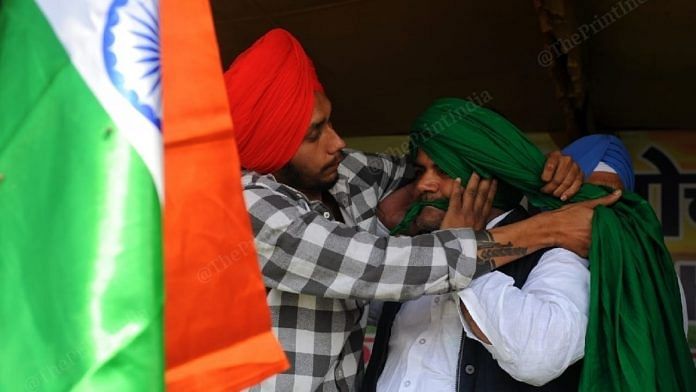
Ghazipur: Arshdeep Singh had a busy but happy day running a ‘pagdi langar’ at the Ghazipur border protest site. On Tuesday, dozens of protesters from all faiths turned up at his langar to get turbans tied on the ‘Pagdi Sambhal Diwas’.
On 23 February, protesters commemorated the 140th birth anniversary of farmer leader Ajit Singh with a ceremonial tying of turbans. Singh had spearheaded the ‘Pagdi Sambhal Jatta’ movement in 1907 to demand the withdrawal of three laws brought in by the British Indian government — Punjabi Land Colonisation Bill, Babri Doab Canal Act, and Punjab Alienation Act.
During a meeting held at Lyallpur on 22 March 1907, Jhang Syal editor Lala Banke Dayal recited his poem, ‘Pagdi Sambhal Jatta’, giving the movement its name.
The ‘Pagdi Sambhal Diwas’ sought to hark back to that movement as the farmer agitation against the Narendra Modi government’s three farm laws continues on the national capital borders.
Speaking to ThePrint, the 19-year-old Arshdeep Singh said, “I have always been enthusiastic about tying pagdis even in my village and became quite skilled at it in my childhood itself. It’s an inherited talent and I am happy to contribute to the movement this way.”
“The turban is symbolic and stands for responsibility that the youth needs to take,” poet Balli Singh Cheema said.
Gulshan Bhatia, a stock broker who lives in Ghaziabad’s Vasundhara, visited the protest site to get a turban. “I am a Bhagat Singh follower and am inspired by the grit farmers have exhibited in this movement. I feel honoured to have this tied around my head,” he told ThePrint.
The revolutionary farmer leader Ajit Singh was the uncle of Bhagat Singh, whose name protesting farmers have invoked.
How farmers are keeping the momentum going
The ‘Pagdi Sambhal Diwas’ is the first in a series of events the farmer leaders have planned till 28 February to engage the agitators at the Ghazipur border, particularly in the absence of Jat and farmer leader Rakesh Tikait, who is holding mahapanchayats in several parts of the country.
“We’ve organised a ‘Kisan Samman’ march in the evening in which farmers will carry out a peaceful march in protest. Tomorrow we’re observing the ‘Daman Virodh Diwas’ under which we’ll send protest notices to district and tehsil offices all over the country,” said Jagtar Singh Bajwa, leader of Kisan Andolan Committee, Tuesday.
“On 26 February, we will organise the ‘Kisan Yuva Diwas’ wherein the youth will take over all the activities of the protests,” Bajwa added.
The Samyukt Kisan Morcha will also be celebrating ‘Kisan Mazdoor Ekta Diwas’ on 27 February on account of the anniversary of Chandra Shekhar Azad’s martyrdom, and Guru Ravidas Jayanti.
To ensure farmers can return to sow Rabi seeds in their fields without losing the agitation strength, the farmer leaders have come up with a roster under which farmer families will return home in batches on predetermined days.
“We’ve come up with rosters to ensure neither our crops nor the agitation is affected,” said Rajveer Singh Jadon, regional head of Bharatiya Kisan Union, one of the protesting unions.
Soaring temperatures have also necessitated the need for the installation of a shed with fans, which will soon come up in front of the stage. Additionally, farmers are preparing to get coolers, table fans, hay and grass to arrange for some possible respite from the heat.
“We’ve ordered for grass from the fields of Tarai and plains of Ganga that keep the atmosphere cool … we’ll make a straw roof with this grass,” Jadon added.
Subscribe to our channels on YouTube & Telegram
Why news media is in crisis & How you can fix it
India needs free, fair, non-hyphenated and questioning journalism even more as it faces multiple crises.
But the news media is in a crisis of its own. There have been brutal layoffs and pay-cuts. The best of journalism is shrinking, yielding to crude prime-time spectacle.
ThePrint has the finest young reporters, columnists and editors working for it. Sustaining journalism of this quality needs smart and thinking people like you to pay for it. Whether you live in India or overseas, you can do it here.